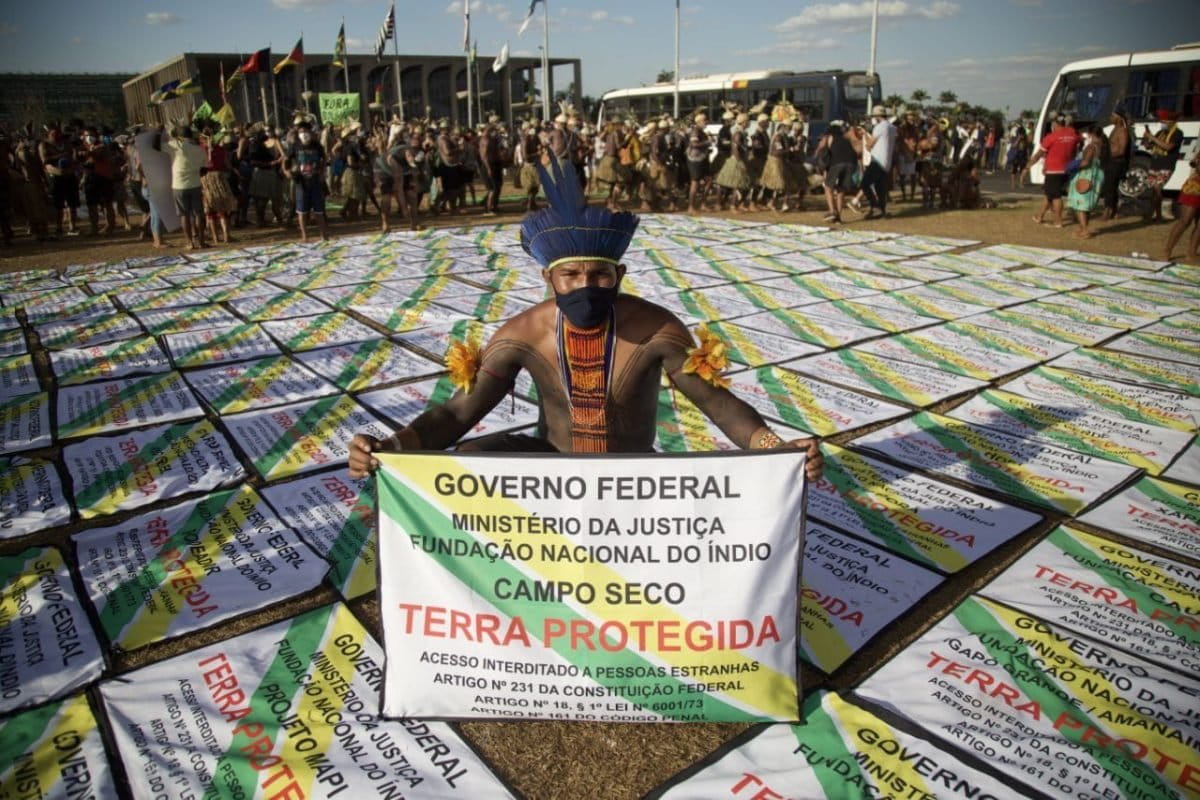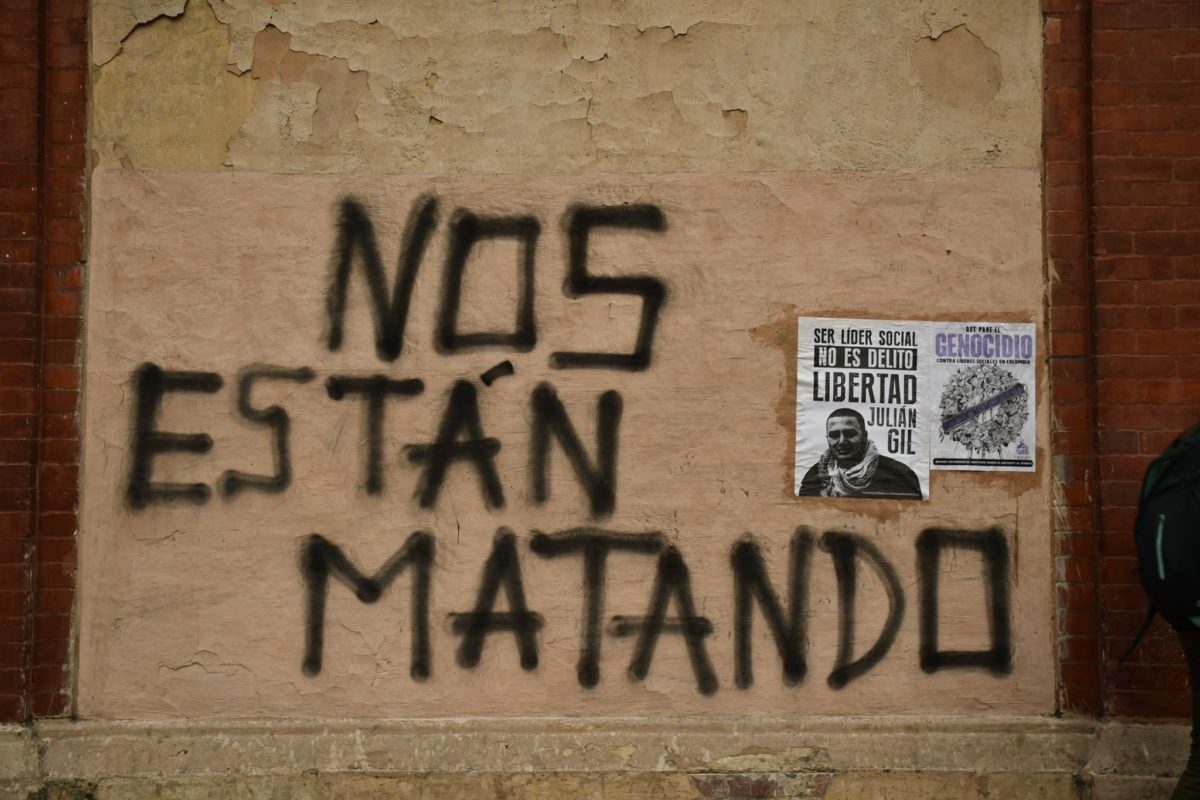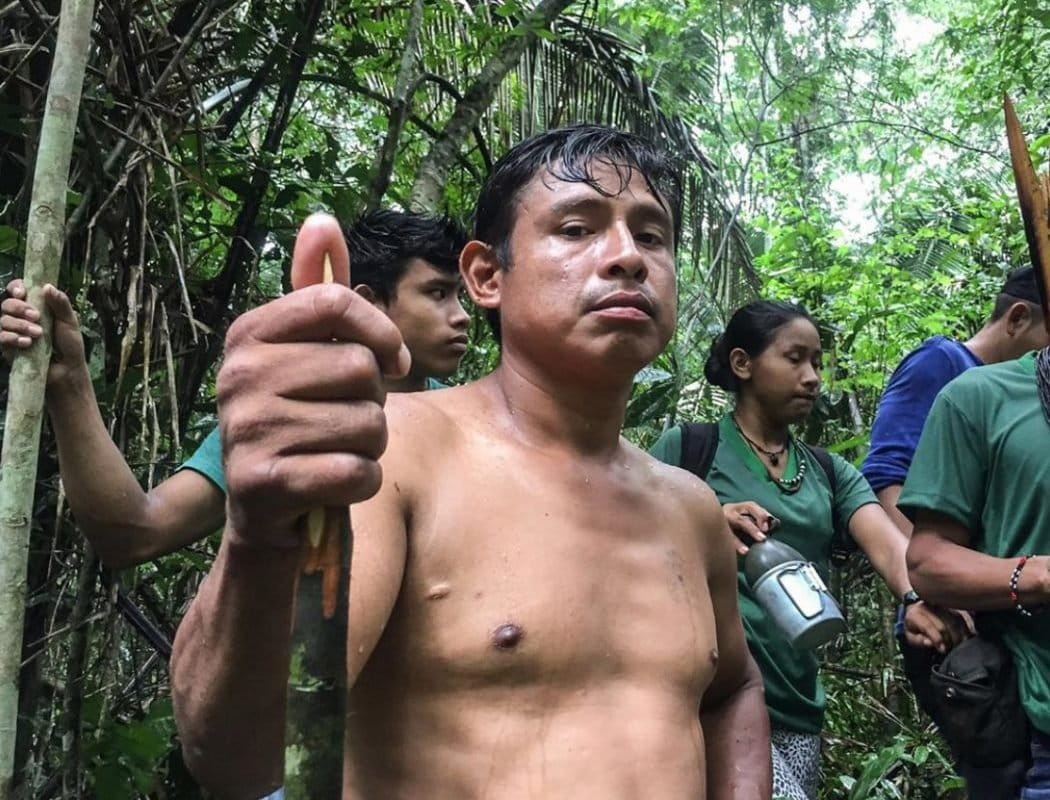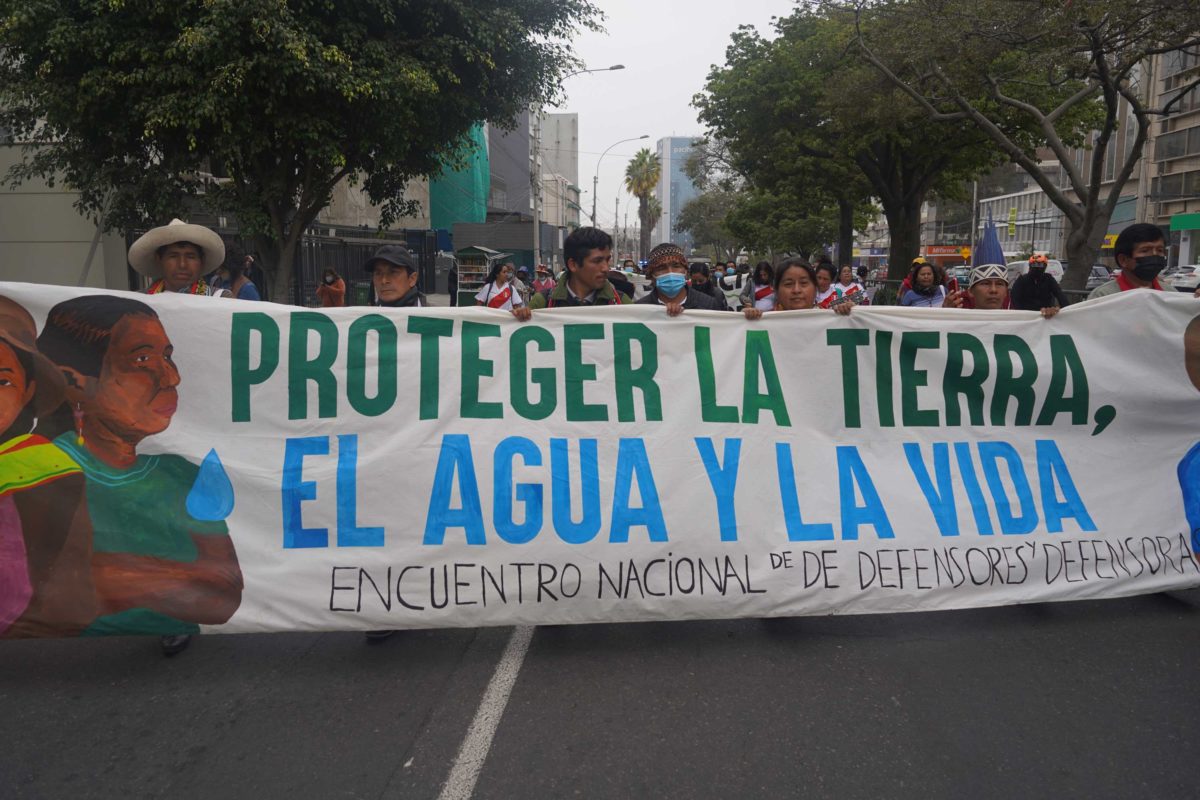- According to information collected by 11 environmental and human rights organizations, 58 Indigenous people were killed in the Brazilian, Colombian, Ecuadoran and Peruvian Amazon between 2016 and 2021.
- Most of the investigations are ongoing and lawyers report delays and irregularities in the processes.
- The likely perpetrators in most of the killings are linked to illegal activities such as drug trafficking, mining, land grabbing and illegal logging.
- In the case of Brazil, experts also point to the state as being potentially involved in these murders.
“We receive reports of murders, crimes and threats every day,” says Esneda Saavedra, counselor for the rights of Indigenous peoples, human rights and peace with the National Indigenous Organization of Colombia (ONIC). She says the victims are now young people and that there’s no guarantee of the cases being solved. “The reports arrive and are archived. We live in a continuous violation of our rights,” she says.
International organizations, including Global Witness and the Inter-American Commission on Human Rights, consistently identify Latin America as one of the regions where Indigenous environmental defenders are most threatened. The most recent Global Witness report shows that most of the killings of land and environmental defenders in 2020 occurred in Latin America, with every three out of four attacks that year in Peru and Brazil taking place in the Amazonian regions of those countries.
“The Amazon has become a disputed territory with armed, illegal groups and the state itself attacking leaders and environmentalists,” says Leonardo Gonzales, project coordinator at the Colombian Institute for Development and Peace Studies (Indepaz). He says the people being killed are those who protect the water, life, and the forest.

Mongabay Latam looked at the killings of Indigenous leaders in four Amazonian countries — Brazil, Colombia, Ecuador and Peru — by examining data collected by 11 environmental and human rights organizations.
The key sources for this work were Global Witness and Front Line Defenders at the regional level; Indepaz and Somos Defensores in Colombia; Amazon Frontlines, the Regional Foundation for Human Rights Advice (INREDH), Amazon Watch and the Alliance for Human Rights in Ecuador; the National Coordinator for Human Rights (CNDDHH) and the Ombudsman’s Office in Peru; and Amnesty International in Brazil.
The cases considered for this investigation cover the period from 2016 to 2021. The results show that of the 58 crimes committed against Indigenous people in the four countries, at least 50 remain unsolved. Most of the pending cases, according to 10 lawyers consulted by Mongabay Latam, are still in the investigation phase or are marred by some kind of irregularity.
Who is behind the crimes?
“We are still heartbroken. We don’t know exactly why this happened,” Tangãi Uru-Eu-Wau-Wau tells Mongabay about his brother’s death. Ari Uru-Eu-Wau-Wau went out for a motorbike ride on April 17, 2020, and never returned. The following day, his body was found in a nearby town in the state of Rondônia, Brazil. According to a government report, he had died from blows to the head. His brother says the family is sad and angry.
Ari Uru-Eu-Wau-Wau had received threats from illegal loggers working inside the Uru-Eu-Wau-Wau Indigenous Territory, according to a statement from the Indigenist Missionary Council (CIMI), a Catholic Church-affiliated group that advocates for Indigenous rights.
This case, and many others like it, share two common features: the existence of previous threats, and the fact that the deaths are related to organized crime.

In Brazil, the rise in the killings of environmental defenders started before the COVID-19 pandemic. Organizations such as Amnesty International Brazil say the administration of President Jair Bolsonaro has encouraged the occupation of ancestral lands and created an environment where protection for Indigenous leaders and land and environmental defenders is lacking. The Global Witness report lists 39 cases of Indigenous people killed in the country between 2016 and 2021, all of which appear to be the work of organized crime.
It’s a similar situation in Colombia. Global Witness recorded at least seven Indigenous defenders killed in the last six years in just the country’s Amazonian region. The likely perpetrators, according to their lawyers, could be paramilitary groups.
During the same period, 10 Indigenous defenders were killed in Peru. The perpetrators were also linked to illegal coca cultivation and drug trafficking activities, as well as criminal groups trafficking in land and timber. Many of these deaths occurred as the Indigenous communities were awaiting land titles for their territories.
In Ecuador, there were two deaths, for which the culprits still haven’t been identified. Amazon Frontlines, INREDH and Amazon Watch say the threats came from people involved in both legal and illegal extractive activities.
In each of the four countries, Mongabay Latam interviewed experts who agree that it’s difficult to keep a record of all the crimes, cases, and progress toward justice. “Evidently, there is a subregistry because you can only gather the most famous cases where there’s been a denouncement, but in many other cases, the families don’t go to the public entities,” says Francisca Stuardo from Global Witness.
Mariel Cabero Ugalde, the environmental justice expert at the Netherlands office of global conservation authority the IUCN, attributes this to a lack of resources. “The fact that they are Indigenous people with low income makes them more vulnerable,” she says, adding that this leaves them in a position with greater problems accessing justice.

Even without a full registry of the crimes against Indigenous land and environmental defenders, the organizations and lawyers interviewed agree that investigations are very slow and, in some cases, don’t even get started.
Sonia Paredes Palma, incidence director at Amnesty International Peru, points to another issue: the lack of justice leads to yet more cases. “We are very worried about the climate of impunity that exists around the murders,” she says. “This is going to lead to proliferation because when there is no justice, there is a bad precedent.”
Brazil: Indigenous leaders threatened by the state
In 2019, Paulino Guajajara’s killing shook Indigenous communities in Brazil. The young leader was shot in the face, allegedly by illegal loggers operating in the Araribóia Indigenous Territory. Guajajara was part of the Guardians of the Forest, an Indigenous patrol that works to protect the Araribóia reserve, where there are also groups living in isolation. Guajajara and other Indigenous leaders in the region had reported constant threats for opposing the invasion of their land and resisting loggers, but no one in power listened to them.
According to the Global Witness report, 39 Indigenous leaders were killed in Brazil between 2016 and 2021. Most of the cases were concentrated in the states of Maranhão, where the Araribóia reserve is located, and Amazonas.
This and the other sources of data that Mongabay Latam consulted indicate that at least 26 of these killings are still under police investigation. Another six are being investigated by prosecutors, while investigations haven’t begun in four cases, and in two cases there isn’t clear information about their current state. Only one case, that of Paulino Guajajara, has reached the trial phase, which will happen this year.
Diogo Cabral, a lawyer with the Federation of Rural Workers in the State of Maranhão, says there’s a sense of impunity in Brazil’s hinterland. “The judicial police carry out the investigation. There is an initial term of 30 days for investigations, but the structure is very poor,” he says. “There aren’t many professionals working in the area. The impunity is due to root problems such as the police’s lack of capacity and willingness to solve cases.”

Jurema Werneck, Amnesty International’s Brazil director, says impunity is the rule. “Most of the cases aren’t investigated, that’s why they don’t reach the next phases of trial or sentencing,” she says. “But when it happens, there isn’t an investment in resources to conduct a proper investigation.”
The experts note that the perpetrators in many of the cases aren’t illegal actors. The state itself, they say, has become a threat to Indigenous defenders.
“The main way in which the government has allowed the increase of violence has been by omission,” Werneck says. “This implies noncompliance with the laws that guarantee that Indigenous, Afro-Brazilian and rural workers without land can live in their territory and receive documents certifying these rights.”
Werneck says the Bolsonaro government has dismantled laws that defend Indigenous peoples and appointed questionable authorities to key posts in Funai, the federal agency for Indigenous affairs. She also says that in some deaths, Indigenous people have pointed to law enforcement agencies as the culprits or as being involved.

A CIMI report published in 2020 says that “the government authorizes violence with speeches against land titling, in favor of forced integration … and disqualification of Indigenous peoples as subjects with rights.” It adds that “Bolsonaro’s policy transformed Indigenous peoples and traditional communities into enemies to fight.” This situation, where the government disowns Indigenous concerns and promotes economic activities in Amazonian territories, is worrisome to environmental organizations.
According to the data gathered for this article, 2016 was the deadliest year for Indigenous defenders, with 14 of them killed. The numbers went down over the next two years — one killing in 2017, and four in 2018 — before going back up to 10 killings each in 2019 and 2020.
Colombia: Defenders in the crossfire
Indigenous leader Maria Bernarda Juanjibioy and her 1-year-old granddaughter were killed on March 17, 2021, in the Putumayo region of Colombia. Juanjibioy was a community leader who rose to be mayor of the town of Kamentzá, where she defended her people’s territory from attempted incursions by illegal armed groups.
“The entire community is appalled by what happened, because they also killed a child. She had mentioned she’d received threats but we weren’t able to talk about it in detail,” says Carmen Juanjibioy, the president of the Association of Orito de Putumayo Indigenous Towns, who worked closely with Maria Bernarda.
According to the Indepaz report analyzing the violence in the region in 2021, 55 Indigenous leaders were killed that year alone. The departments of Cauca and Antioquia were the deadliest. Within the Colombian Amazon, seven Indigenous leaders were killed between 2016 and 2021, with loggers, paramilitary groups and other criminal organizations the likely culprits. All of those killed had fought for the defense of land and the environment.
The Amazon regions with the highest rates of Indigenous and environmentalist murders are Putumayo and Caquetá, says Indepaz’s Leonardo González. He adds the communities there are being displaced by this violence. “Those committing the murders are armed groups that force people to leave and abandon their territory.”

Mongabay Latam’s analysis established that of the seven killings of Indigenous people, only one, the death of Miguel Muchavisoy, ended in a jail sentence for the perpetrator. Four others are still being investigated by prosecutors and one by police; there is no updated information for the last one.
ONIC has made a public call to investigate the killing of Maria Bernarda Juanjibioy and bring her killers to justice. “We are losing ancestral knowledge, living in fear, hostility, and the dispossession is leaving us without land or food,” says ONIC’s Esneda Saavedra. “With the death of Indigenous women and men we live unsafe in our own home.”
Although the prosecutor’s office has said there’s been progress in 10% of the cases, human rights organizations say they’re skeptical.
Indepaz’s Leonardo González says there are no concrete data about crimes against environmental defenders in the Amazon. “We don’t have a lot of information because everything is classified,” says Lourdes Castro, a coordinator with Somos Defensores. She says the prosecutor’s office in Colombia isn’t transparent with information about trials and sanctions.
Maria Bernarda Juanjibioy’s case is under investigation and the family didn’t receive a settlement until recently, says Carmen Juanjibioy. “We need to pretend we don’t know anything, we don’t hear anything, because in the Amazon there are many mafias, may illegal groups,” she says. “There were many hypotheses about María Bernarda’s death, the Comando de Frontera [a paramilitary group working on the border between Colombia and Peru] even released a statement saying they weren’t involved.”
For Castro from Somos Defensores, the situation in Colombia is linked to the multiple legal and illegal actors who are in conflict in the region, with the Indigenous communities caught in the middle. “Due to inadequate implementation of the peace agreement of 2016, we saw a new configuration of the conflict dynamics that has helped armed groups to keep growing and consolidating, and they control certain areas of Colombia.”
In a report, Amnesty International noted an increase in the killings of environmental defenders since the signing of the peace agreement between the Colombian government and the armed rebel group the FARC. The report also highlighted the increased vulnerability of Indigenous people under the COVID-19 pandemic.
Castro says ratifying the Escazú Agreement — a regional pact on “access to information, public participation and justice in environmental matters in Latin America and the Caribbean” — would show real political will to increase the protection of leaders. Colombia, Brazil, Ecuador and Peru have all signed the agreement, though only Colombia and Ecuador have ratified it.
“There would be more attention from the international community and it would mean that the other Latin American countries would look at our country to demand respect and protection,” Castro says.
Peru: A ‘joke’ of a sentence for a killing
On April 12, 2020, a month after the government of Peru imposed a COVID-19-related lockdown, Indigenous Cacataibo leader Arbildo Meléndez was killed. His sister, Sarita Meléndez, says the family had asked Arbildo to leave the Indigenous community of Unipacuyacu and come to the city of Pucallpa, where he would be safer. “He was always receiving threats from land traffickers.” But remaining in Unipacuyacu to continue his fight to obtain land titles and defend the community were more important for Arbildo Meléndez.
“Unipacuyacu will get titles on my spilled blood,” he used to say. Sarita said she was scared of hearing that because she knew that things were different from when they were children. “When he was 10 and I was 12, we’d go to the borders of Unipacuyacu because we’d heard there were traffickers who wanted to take our land for coca,” she says. “Arbildo used to tell me that when he became a man he would fight for the community. But now you get killed if you want to defend it.”

Not only are defenders being killed, but their perpetrators are going unpunished. Or the sentence might be a joke, as Sarita Meléndez puts it. After two years of investigations, the perpetrator in her brother’s killing was sentenced to four years in prison. The family’s lawyer, Sandra Olivera, says that type of sentence applies to the charge of culpable homicide, punishable by up to eight years in prison. “We are appealing to make it an assassination charge, where there can be up to 35 years of prison,” she says.
Olivera adds that even though there’s enough evidence to investigate the mastermind behind the killing, there still hasn’t been an investigation.
Olivera has also become a target due to her work. “They found out where my parents live and they tell me to drop the case,” she says. “That’s why now I have security guards, as the police don’t protect [us].”
For all its setbacks, Meléndez’s case is the rare exception where there’s been some progress toward justice in the last six years. According to the information collected by environmental and human rights organizations and the lawyers following the cases, his is the only one of the 10 killings in the Peruvian Amazon during that period that has gone to trial. Seven other killings are currently being investigated by prosecutors, while the other two aren’t being tracked by Indigenous organizations so their current state remains unknown.
Jorge Chauca, president of the Regional Association of Indigenous Peoples of the Central Rainforest (ARPI), says there’s no willingness from the authorities to get to the bottom of the cases and find the killers. He cites cases where there’s been no progress and concerns for people who disappeared in 2021. “We don’t know if they are dead or alive. Indigenous peoples are still being threatened and persecuted all the time.”

Those closest to the victims are the ones who feel the most threatened when they go public with a case, according to Carlos Quispe Dávila, a lawyer for the NGO Environmental Rights & Justice (DAR). “The families of murdered defenders are left in a precarious situation,” he says. “They also feel deep mistrust. There have been cases in which they receive threats as retaliation for denouncing and they become the target of criminals.”
The rise in illegal activities in the Amazon, helped by the pandemic, has meant even greater risks for defenders. As the threats increased, so too did the killings. According to the National Coordination of Human Rights, seven Indigenous defenders were killed in the Peruvian Amazon between 2012 and 2019, while in the last two years, 2020 and 2021, there were nine killings.
Mar Pérez, a specialist with the National Coordination of Human Rights, says she’s concerned about the climate of impunity that this lack of justice is creating. She says some illegal activities, such as land trafficking or drug trafficking, employ hitmen, and adds that it’s important to focus not only on who committed the crime but on who is behind it, driving the criminal networks.
Chauca agrees that the illegal activities are putting environmental defenders in a dangerous situation. “Especially drug trafficking. You can’t say anything, speak out, or talk with the media, because then you are marked as a snitch,” he says. Killings occur, he says, as the culmination of a series of constant threats. And while the victims sometimes file a report, they face a big obstacle: the authorities fail to provide them with security. That was the case for Edwin Chota, an Indigenous Asháninka in Saweto, Ucayali, who was constantly facing down logging mafias.

Sonia Paredes of Amnesty International Peru says these illegal sectors have transnational interests spanning neighboring countries. “This increase of attacks on land defenders isn’t an isolated phenomenon,” she says. “Although there was an agrarian reform process in Peru, the land is still in conflict and many times it’s related to titling and the presence of mafias that are part of an international criminal network.”
Ecuador: No Indigenous access to justice
The last killing of an Indigenous leader in the Ecuadoran Amazon was that of Nange Yeti, a pikenani, or wise elder, of the Waorani nation. He disappeared on Dec. 19, 2021, in the province of Pastaza. Two days later, he was found dead: he’d been beaten on the head and had cuts on his neck. A report was filed a few days after, but it wasn’t until March 21, 2022, that authorities arrived in the Waorani territory to exhume the body. Six months after the killing, the case is still being investigated and the process could take more than two years. Initial suspicions point to illegal miners and loggers in the area who had previously threatened the Waorani elder and his family.
María Espinosa, a lawyer in the case and legal coordinator with Amazon Frontlines, says the exhumation process didn’t respect cultural practices. “They left the body uncovered because it started to rain,” she says. “The Waorani guard had to go and protect it.”
Vivian Idrovo, coordinator with the Human Rights Alliance, says this case is an example of how intercultural mechanisms aren’t respected, making Indigenous access to justice almost impossible.

Maria Taant was another Indigenous leader who was killed in 2021. She was run over by a motor vehicle, having previously also been subjected to threats for her work defending the land. But an investigation into her death hasn’t started yet, according to the women’s organization Mujeres Amazónicas.
According to the information collected by Mongabay Latam, of the five environmental defenders murdered in Ecuador since 2013, four were Indigenous leaders. None of these cases went beyond an investigation by prosecutors, including that of Freddy Taish, a young Shuar man who was shot in the head in an operation against illegal mining.
Luisa Villacís, a lawyer in the case and legal adviser with rights advocacy group INREDH, says that in 2020, Taish’s family filed a petition with the U.N. Commission on Human Rights, asking it to send recommendations to the Ecuadoran government to solve the case. “There is no type of public policy in Ecuador that safeguards the work that human rights and environmental defenders do,” she says. While the Ombudsman’s Office initiated work to address the issue in 2019, this was stopped due to the pandemic.
André Rangel, South America campaigner for Amnesty International, says this work started thanks to a recommendation from Amnesty to implement an integrated policy to protect defenders. “We believe that the mechanisms aren’t sufficiently effective because there isn’t a budget or plan to answer to these people’s needs,” he says. “It’s necessary to admit their legitimacy and importance publicly to give priority to their defense.
“On top of the lack of clear public policies to defend them, there isn’t due diligence by the Ecuadoran authorities,” he adds. “That’s why we are taking the case to the international level.”

According to Rangel, impunity shouldn’t be measured in terms of waiting time alone. He recommends a wider look at the problem. “We talk about impunity when we identify certain worrying elements like excluding investigation lines linked to the defenders’ work, not assigning enough staff or resources, or not identifying the intellectual authors.”
Banner image by Kipu Visual.
Editor’s note: Mongabay Latam received funding from Hivos–Todos los ojos en la Amazonía to develop a series of investigative articles about the situation of Indigenous peoples in Peru, Ecuador and Brazil. Mongabay maintains complete editorial independence over the stories reported using this funding, and Hivos–Todos los ojos en la Amazonía has no editorial input on Mongabay content.
This story was reported by Mongabay’s Latam team and first published here on our Latam site on June 30, 2022.
